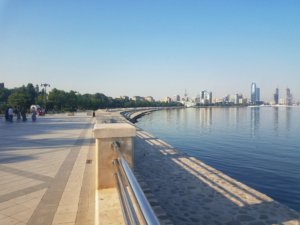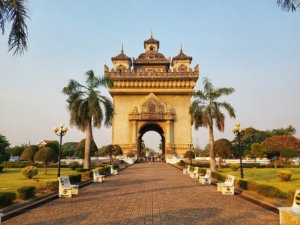Sweltering in tropical heat at the confluence of the Tonle Sap and Mekong Rivers, Phnom Penh is one of Southeast Asia’s most delightful and underrated cities.The Cambodian capital city is quietly making a name for itself as one of the brightest and most vibrant gems among Southeast Asian cities.

Cambodia has a rich history that goes back thousands of years. Most tourists to the country explore no further than the temples of Angkor and miss out on this city. Phnom Penh is the center of Cambodian politics, culture, food, history and life, making the “Charming City” a great stop on tours of Southeast Asia.
Phnom Penh is best seen with an open mind and an adventurous spirit. The city has a tremendous amount to offer tourists, especially for travelers interested in a little wandering. The tourist highlights of Phnom Penh are excellent, but the city beyond is even more interesting. That begins with the food.
Food in Phnom Penh
Cambodia is not a top food destination when compared to the likes of Thailand or Vietnam. That being said, there is an abundance of delicious food in the country. Eating good, local food in other parts of Cambodia can be a challenge. In Phnom Penh, it’s a breeze.
Phnom Penh has thousands of restaurants lining the streets, featuring all sorts of regional cuisines. For Cambodian food, take your pick. Areas around markets, particularly the blocks between Preah Sihanouk Blvd and the Tuol Seng Genocide Museum, are full of restaurants. Choose one that piques your interest, employ the point-and-guess method, then enjoy some great Cambodian food.

On the tourist trail, David’s Homemade Noodles & Dumplings is a popular restaurant with tourists. It features noodles made to order from scratch. The dumplings are also homemade, and though it may not be the most hidden secret in Phnom Penh, this restaurant is cheap and delicious. Outside of tourist circles, the many open air cafes lining the streets offer super cheap, fresh and uniquely local eating.
Hops Brewery & Craft Beer Garden
While the craft beer industry is raging in North America, small breweries are just emerging in Southeast Asia. Thailand has several craft breweries, Vietnam a few and one in Myanmar, as well. Perhaps the best of all craft breweries in Southeast Asia is Hops Brewery & Craft Beer Garden in Phnom Penh.

Hops is owned and operated by a German expat, and brewing is strictly in accordance with Reinhetsgebot, the German Beer Purity Law of 1516. The beer garden also serves a variety of high quality German food to pair with your perfect brews.
Hops is expensive, especially by Cambodian standards. But when you’re in need of a quality beer in Phnom Penh, Hops is the place to splurge.
Check out the Hangry Backpacker’s guide to beer in Southeast Asia for further insight on our favorite frothy beverage in the region.
Cheap Beer on the Mekong
One of the best things about Phnom Penh is the ability to enjoy a beer in a perfect location for less than a dollar. (The US Dollar, by the way, is the currency of preference in Cambodia.)
At some point, it is inevitable that most visitors need an escape from the intense Southeast Asian heat. And, somehow, Phnom Penh may actually be hotter than other cities in the area. What better form of relief is there, if not cheap ice-cold beers?

The Foreign Correspondents’ Club in Phnom Penh is a great spot to watch the Mekong creep by and enjoy a few drinks. The hotel has a rooftop bar with live music a few nights a week. In the daytime, it is largely empty.
If you want cheap drinks, as in $1 tops for a beer, the bars on the corner opposite the Foreign Correspondents’ Club is your refuge. There is a bar on street level that is very comfortable. For a better view, and maybe a slight breeze, there are bars on the second and third levels, as well. These have a better view, too.
Every city has that one location that is perfect for a cold beer and people watching. Usually, thirsty travelers pay a hefty price for that view. Watching the Mekong flow by in Phnom Penh, the upcharge is only a buck.
Drink up, and enjoy the view.
Khmer Rouge Reminders
Phnom Penh has a deep and storied history, with a turbulent past dominating headlines over the last 50 years. The best way to learn about a country is to understand the people. Understanding the people of Cambodia means learning about the horrors of the Khmer Rouge in the not-so-distant past.
After the French left Southeast Asia, the struggle for power resulted in decades of war and violence in the region. Cambodia was stable for a time and proudly known as “the Pearl of Asia.” When the Khmer Rouge gained power, the country changed. Peace, freedom and happiness was replaced with war, oppression and famine.
The Khmer Rouge, led by Pol Pot, killed millions of minorities and dissidents in the 1970s. In the years following the demise of the Khmer Rouge, the scale of atrocities came to light. Phnom Penh has two important sites for visitors to see, the Killing Fields and the Tuol Seng Genocide Museum.


The Killing Fields are fairly self-explanatory. Choeung Ek Genocide Center is the site of a mass graves of thousands of victims. The Tuol Send Genocide Museum was once a school, then became a prison and torture center under Pol Pot’s regime.
Neither of these places is cheerful, but each is important for foreign visitors to better understand the Cambodian people. The horrors of the Khmer Rouge took the lives of about one quarter of the country’s population not that long ago, and the effects are still visible today. Take the time to visit these sites to learn about Cambodia and gain a better understanding of the surrounding people and places.
Parks & Public Spaces
Driving through Phnom Penh in the summertime, visitors will see locals out and about enjoying their city’s public spaces. Parks are full of runners, aerobics classes, kids playing games and people just enjoying the sunshine. Wat Botum Park and the park near the Independence Monument are particularly fun to wander at this time.

I really can’t emphasize how hot it gets in Phnom Penh. These parks are fairly empty throughout the day, but when the sun starts heading down, things pick up. By sunset, Phnom Penh parks are full and the Mekong Riverside Park is the place to be. Music is playing and street food is cooking. This is definitely a fun time to wander Phnom Penh.
Temples of Phnom Penh
Blending in with the remaining marks from the French colonial era, Phnom Penh is full of historic buildings, ornate Buddhist temples and striking displays of Cambodian architecture.
Buddhist temples stand out in Southeast Asia, and Phnom Penh is no exception. In a sea of people, grime and poverty, suddenly there is a lavish temple. The temples show the reverence and importance of Buddhism to the people of Phnom Penh – and, judging by these fancy buildings, it must be really important.

Wat Botum is a temple that dates back to the 15th century. It is a perfect example of Buddhist architecture seen throughout Phnom Penh and the rest of Cambodia.
Not far from Wat Botum is the Royal Palace of Cambodia. The park across the street is a popular hangout for locals, but the palace itself is the sight to see. The Royal Palace of Cambodia is a stunning complex.
Wat Ounalom is a beautiful complex that is the center of Cambodian Buddhism. Wat Phnom is the most historically important Buddhist structure in Phnom Penh, but unlike other temples, there is a fee to enter.
The Independence Monument is just a monument. It’s cool, and it’s photogenic. But it’s just a monument. Across the street is the Norodom Sihanouk Memorial. Nearby Wat Langka is another pretty temple.
Buddhism is clearly an integral part of life in Phnom Penh. There are too many temples to count. They are each stunning and visually overwhelming in a uniquely different way. Some of the more important temples are off limits to visitors, while others are free and open to exploration.
Remember to be respectful. That includes dressing appropriately and maintaining a quiet presence.
Phnom Penh Central Market
Phnom Penh has a lot of huge markets for tourists to explore. The Russian Market receives a lot of attention, but Central Market is the largest and most famous.
Phnom Penh Central Market is the place to find anything and everything. Whether you’re after jewelry, a new purse, souvenirs, shampoo, a new pair of sunglasses or fresh food, Central Market has everything.

The market is located in the Phnom Penh city center, about a 10-minute walk from Riverside Park and the Mekong. The surrounding area is also host to a lot of eating options.
The most important thing to remember about Phnom Penh Central Market – and all markets in Southeast Asia – is to haggle. Prices on goods are cheap, but vendors see dollar signs in passing tourists. Initial quotes on goods may seem cheap, but are likely considerably higher than actual prices. Don’t be afraid of a little back-and-forth bartering. It’s okay to pay a small surcharge, your “tourist tax,” but don’t let people take advantage of a shy tourist. That’s a slippery slope.


Central Market in Phnom Penh is the place to go for any odds or ends that need replacing while traveling. It is also a great location for souvenirs, a local bite to eat and a big slice of local life in Phnom Penh.
The Next Bangkok?
Bangkok is overrun with tourists. Sure, it’s still a fascinating city where a traveler can have a lot of fun. But it’s overrun with tourists and is the marker of changing travel in Southeast Asia. Most travelers don’t imagine walking through Bangkok and seeing dozens of Westerners on every block, but that’s the reality of the Southeast Asian megacity.
Phnom Penh is known as the steaming Mekong capital city of Cambodia. As far as the big cities of Southeast Asia, Phnom Penh is not the most popular. That recognition goes to Bangkok, with cities like Singapore and Hanoi in the mix as well.
Phnom Penh, Cambodia is one of the most interesting cities in Southeast Asia. It is cheaper than Bangkok and, lacking the scale of tourism found in Thailand, offers more authenticity to visitors. The city is poised to be the next big destination in Southeast Asia. With a little fortune and (a lot of) improvements to infrastructure, Cambodia may be in for some drastic changes.

Unfortunately, the government of Cambodia is disregarding the well-being of its citizens and is cashing in on Chinese checks. This is another roadblock in the way of long-term prosperity.
Siem Reap, the gateway to Angkor Wat, is a perfect example of how Cambodia is changing. The city is much smaller than Phnom Penh, but it is full of massive hotels and other attractions for tourists, all on a decent network of roads.
As travelers tire of tourist crowds in Bangkok, other cities will grow in popularity. Phnom Penh has everything necessary to become a major center of tourism. Only time – and incompetent, oppressive governments – will determine its fate.
Phnom Penh is the overlooked gem of the Mekong River. With other major cities receiving more attention, Phnom Penh quietly matures and develops into a wonderful Southeast Asian travel destination.
In recent years, Cambodia has transformed into a popular tourist destination, largely thanks to international awareness of Angkor Wat. The rest of the country lags far behind, but Phnom Penh is somewhere in between. For a city with centuries of history, beautiful buildings, great food around every corner and the perfect spot for a cheap beer on the Mekong, Phnom Penh is the perfect destination.



















You must be logged in to post a comment.